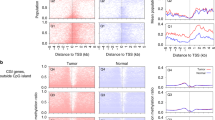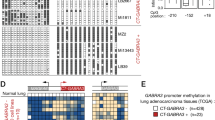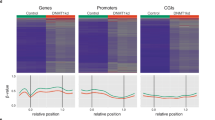Abstract
Densely methylated DNA associates with transcriptionally repressive chromatin characterized by the presence of underacetylated histones1,2. Recently, these two epigenetic processes have been dynamically linked. The methyl-CpG-binding protein MeCP2 appears to reside in a complex with histone deacetylase activity3,4. MeCP2 can mediate formation of transcriptionally repressive chromatin on methylated promoter templates in vitro, and this process can be reversed by trichostatin A (TSA), a specific inhibitor of histone deacetylase3,4,5. Little is known, however, about the relative roles of methylation and histone deacetylase activity in the stable inhibition of transcription on densely methylated endogenous promoters, such as those for silenced alleles of imprinted genes6, genes on the female inactive X chromosome7 and tumour-suppressor genes inactivated in cancer cells8,9. We show here that the hypermethylated genes MLH1, TIMP3 (TIMP-3), CDKN2B (INK4B, p15) and CDKN2A (INK4, p16) cannot be transcriptionally reactivated with TSA alone in tumour cells in which we have shown that TSA alone can upregulate the expression of non-methylated genes. Following minimal demethylation and slight gene reactivation in the presence of low dose 5-aza-2´deoxycytidine (5Aza-dC), however, TSA treatment results in robust re-expression of each gene. TSA does not contribute to demethylation of the genes, and none of the treatments alter the chromatin structure associated with the hypermethylated promoters. Thus, although DNA methylation and histone deacetylation appear to act as synergistic layers for the silencing of genes in cancer, dense CpG island methylation is dominant for the stable maintenance of a silent state at these loci.
This is a preview of subscription content, access via your institution
Access options
Subscribe to this journal
Receive 12 print issues and online access
$209.00 per year
only $17.42 per issue
Buy this article
- Purchase on Springer Link
- Instant access to full article PDF
Prices may be subject to local taxes which are calculated during checkout




Similar content being viewed by others
References
Antequera, F., Macleod, D. & Bird, A.P. Specific protection of methylated CpGs in mammalian nuclei. Cell 58, 509–517 (1989).
Eden, S., Hashimshony, T., Keshet, I., Cedar, H. & Thorne, A.W. DNA methylation models histone acetylation [letter] [In Process Citation]. Nature 394, 842 (1998).
Nan, X. et al. Transcriptional repression by the methyl-CpG-binding protein MeCP2 involves a histone deacetylase complex [see comments]. Nature 393, 386–389 (1998).
Jones, P.L. et al. Methylated DNA and MeCP2 recruit histone deacetylase to repress transcription. Nature Genet. 19, 187– 191 (1998).
Yoshida, M., Horinouchi, S. & Beppu, T. Trichostatin A and trapoxin: novel chemical probes for the role of histone acetylation in chromatin structure and function. Bioessays 17, 423–430 ( 1995).
Barlow, D.P. Gametic imprinting in mammals. Science 270, 1610–1613 (1995).
Wolf, S.F., Jolly, D.J., Lunnen, K.D., Friedmann, T. & Migeon, B.R. Methylation of the hypoxanthine phosphoribosyltransferase locus on the human X chromosome: implications for X-chromosome inactivation. Proc. Natl Acad. Sci. USA 81, 2806–2810 (1984).
Herman, J.G. et al. Silencing of the VHL tumor-suppressor gene by DNA methylation in renal carcinoma. Proc. Natl Acad. Sci. USA 91, 9700–9704 (1994).
Herman, J.G. et al. Inactivation of the CDKN2/p16/MTS1 gene is frequently associated with aberrant DNA methylation in all common human cancers. Cancer Res. 55, 4525–4530 ( 1995).
Herman, J.G. et al. Incidence and functional consequences of hMLH1 promoter hypermethylation in colorectal carcinoma. Proc. Natl Acad. Sci. USA 95, 6870–6875 (1998).
Herman, J.G., Jen, J., Merlo, A. & Baylin, S.B. Hypermethylation-associated inactivation indicates a tumor suppressor role for p15(INK4B). Cancer Res. 56, 722–727 (1996).
Archer, S.Y., Meng, S., Shei, A. & Hodin, R.A. p21(WAF1) is required for butyrate-mediated growth inhibition of human colon cancer cells. Proc. Natl Acad. Sci. USA 95, 6791– 6796 (1998).
Datto, M.B., Hu, P.P., Kowalik, T.F., Yingling, J. & Wang, X.F. The viral oncoprotein E1A blocks transforming growth factor β-mediated induction of p21/WAF1/Cip1 and p15/INK4B. Mol. Cell. Biol. 17, 2030–2037 (1997).
Tazi, J. & Bird, A. Alternative chromatin structure at CpG islands. Cell 60, 909– 920 (1990).
Costello, J.F., Futscher, B.W., Kroes, R.A. & Pieper, R.O. Methylation-related chromatin structure is associated with exclusion of transcription factors from and suppressed expression of the O-6-methylguanine DNA methyltransferase gene in human glioma cell lines. Mol. Cell. Biol. 14 , 6515–6521 (1994).
Wong, J. et al. Distinct requirements for chromatin assembly in transcriptional repression by thyroid hormone receptor and histone deacetylase. EMBO J. 17, 520–534 ( 1998).
Pederson, D.S. & Morse, R.H. Effect of transcription of yeast chromatin on DNA topology in vivo. EMBO J. 9, 1873–1881 (1990).
Drabik, C.E., Nicita, C.A. & Lutter, L.C. Measurement of the linking number change in transcribing chromatin. J. Mol. Biol. 267, 794– 806 (1997).
Lutter, L.C., Judis, L. & Paretti, R.F. Effects of histone acetylation on chromatin topology in vivo. Mol. Cell. Biol. 12, 5004– 5014 (1992).
Kass, S.U., Landsberger, N. & Wolffe, A.P. DNA methylation directs a time-dependent repression of transcription initiation. Curr. Biol. 7, 157–165 (1997).
Kaslow, D.C. & Migeon, B.R. DNA methylation stabilizes X chromosome inactivation in eutherians but not in marsupials: evidence for multistep maintenance of mammalian X dosage compensation. Proc. Natl Acad. Sci. USA 84, 6210–6214 (1987).
Riggs, A.D., Xiong, Z., Wang, L. & LeBon, J.M. Methylation dynamics, epigenetic fidelity and X chromosome structure. Novartis Foundation Symposium 214, 214-225; discussion 225-232 (1998).
Chen, Z.J. & Pikaard, C.S. Epigenetic silencing of RNA polymerase I transcription: a role for DNA methylation and histone modification in nucleolar dominance. Genes Dev. 11, 2124– 2136 (1997).
Selker, E.U. Trichostatin A causes selective loss of DNA methylation in Neurospora. Proc. Natl Acad. Sci. USA 95, 9430– 9435 (1998).
Chomczynski, P. & Sacchi, N. Single-step method of RNA isolation by acid guanidinium thiocyanate- phenol-chloroform extraction. Anal. Biochem. 162, 156– 159 (1987).
Herman, J.G., Graff, J.R., Myohanen, S., Nelkin, B.D. & Baylin, S.B. Methylation-specific PCR: a novel PCR assay for methylation status of CpG islands. Proc. Natl Acad. Sci. USA 93, 9821–9826 ( 1996).
Gerber, A.N., Klesert, T.R., Bergstrom, D.A. & Tapscott, S.J. Two domains of MyoD mediate transcriptional activation of genes in repressive chromatin: a mechanism for lineage determination in myogenesis. Genes Dev. 11, 436–450 ( 1997).
Herman, J.G., Jen, J., Merlo, A. & Baylin, S.B. Hypermethylation-associated inactivation indicates a tumor suppressor role for p15INK4B. Cancer Res. 56, 722–727 ( 1996).
Kane, M.F. et al. Methylation of the hMLH1 promoter correlates with lack of expression of hMLH1 in sporadic colon tumors and mismatch repair-defective human tumor cell lines. Cancer Res. 57, 808–811 (1997).
Wick, M. et al. Structure of the human TIMP-3 gene and its cell cycle-regulated promoter. Biochem. J. 311, 549– 554 (1995).
Acknowledgements
The authors thank A. Wolffe, K. Kinzler and J. Bender for helpful advice and comments on this work; M. Rountree for scientific advice; K. Polyak for helpful advice and for providing the RT primer sequences for MLH1; B. Vogelstein for providing the RT primer sequences for CDKN1A; B. Vogelstein and K. Kinzler for initial supplying of RKO and SW480 cells; and F. Ruscetti for supplying HL60 cells.
Author information
Authors and Affiliations
Corresponding author
Rights and permissions
About this article
Cite this article
Cameron, E., Bachman, K., Myöhänen, S. et al. Synergy of demethylation and histone deacetylase inhibition in the re-expression of genes silenced in cancer. Nat Genet 21, 103–107 (1999). https://doi.org/10.1038/5047
Received:
Accepted:
Issue Date:
DOI: https://doi.org/10.1038/5047
This article is cited by
-
In vivo kinetics of early, non-random methylome and transcriptome changes induced by DNA-hypomethylating treatment in primary AML blasts
Leukemia (2023)
-
Chidamide, Decitabine, Cytarabine, Aclarubicin, and Granulocyte Colony-stimulating Factor Therapy for Patients with Relapsed/Refractory Acute Myeloid Leukemia: A Retrospective Study from a Single-Center
Current Medical Science (2023)
-
Methylation Mediated Downregulation of TOB1-AS1 and TOB1 Correlates with Malignant Progression and Poor Prognosis of Esophageal Squamous Cell Carcinoma
Digestive Diseases and Sciences (2023)
-
New insights into epigenetic regulation of resistance to PD-1/PD-L1 blockade cancer immunotherapy: mechanisms and therapeutic opportunities
Experimental Hematology & Oncology (2022)
-
Epigenetic restoration and activation of ERβ: an inspiring approach for treatment of triple-negative breast cancer
Medical Oncology (2022)



